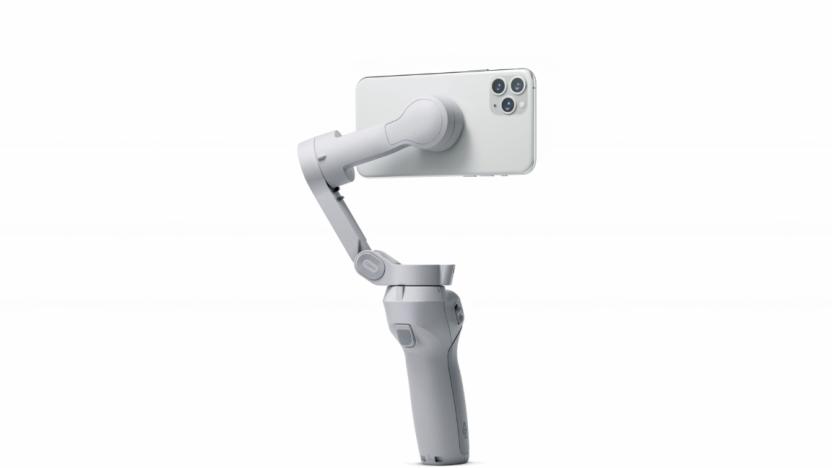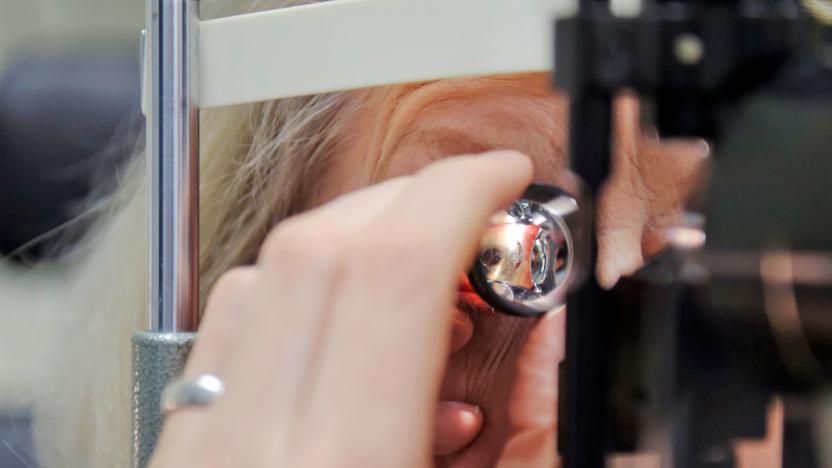magnetic
Latest

DJI’s next smartphone gimbal might have a magnetic quick mount system
Leaked images show DJI's Osmo Mobile 4 smartphone gimbal with a new magnetic mount system.

Block-like robots could assemble into emergency staircases
Next to Boston Dynamics' leaping humanoids, the dice-like M-Block robots from MIT might not look very cool. Considering their lack of limbs, though, the latest versions can perform some impressive tricks like jumping, climbing and assembling into larger structures, Big Hero 6 style. Those skills could one day help them assemble themselves into a staircase to rescue survivors trapped in a building, or be used as real-world Minecraft blocks.

MIT’s thread-like robot can slip through blood vessels in your brain
MIT engineers created a thread-like robot that can glide through the brain's blood vessels and could deliver clot-reducing drugs to treat strokes or aneurysms. The robotic thread could offer an alternative to open brain surgery, and it could be controlled by surgeons outside of the operating room. Theoretically, surgeons could control it remotely from an entirely different location.

MagSafe makes a full comeback for your USB-C MacBooks
One feature that seasoned MacBook users may miss is the good ol' MagSafe connector, because no one wants to accidentally drag a pricey laptop off the table. Alas, ever since Apple made the jump to USB-C, it decided to retire its handy magnetic invention -- it even stopped short at releasing a MagSafe-to-USB-C adapter. There have since been a few third-party alternatives, with the earlier ones handling just power delivery (like Griffin's BreakSafe cable), followed by the more advanced data transmitting types with mixed reviews -- they tend to be bulky, nor did they support Thunderbolt 3's full bandwidth, apparently. This is where ThunderMag comes in. Developed by Innerexile over the past three years, this little gadget is claimed to be the world's first truly Thunderbolt 3-compatible magnetic adapter. In other words, ThunderMag can pass through data at up to 40 Gbps (or video at up to 5K) while also delivering 100W of power, thanks to its 24 pins and delicate magnetic shaping -- the latter to protect the cable's high-frequency signal. And of course, the ThunderMag isn't exclusive to MacBooks; just plug it into any Thunderbolt 3 or USB-C port on a device and you're good to go.

Earth's fast-moving magnetic north pole is messing with navigation
The Earth's magnetic north pole is constantly on the move, but it's now enough of a problem that it's having a significant effect on navigation technology. Scientists at the National Centers for Environmental Information have delivered an update to the World Magnetic Model a year early after "unplanned variations in the Arctic region" (read: quick movements) made the existing magnetic north inaccurate. That's a problem for virtually every device with a magnetic compass, including smartphones, military vehicles and airliners.

Magnetic eye implants could save the eyesight of glaucoma patients
Glaucoma patients can use implants to treat the condition by draining the eye, but the existing technology rarely lasts more than a few years thanks to the accumulation of microorganisms that wreck the functionality. A Purdue-led team might have a clever technological solution, though: magnetism. The group has developed a smart implant that cleans itself with microactuators that vibrate whenever you induce a magnetic field. It would not only be far more reliable, but could be customizable as well.

Magnetized particles could solve our data storage problems
Scientists have discovered an unusual magnetic behavior that could solve one of the biggest problems faced by our data-hungry world: data storage. In recent decades we've been getting progressively better at storing data but unless we find new and more efficient ways to store the increasing volume of data we're producing every day, it won't be long until data centres reach their capacities and progress grinds to a halt. The new discovery, which has the potential to store data in fast-moving magnetic particles, could remedy that.

Touchable BlindPad puts visual information at your fingertips
This touchscreen tablet operates differently than your usual iPad, with 192 magnetic buttons across its 12 x 15cm surface. They can move up and down almost instantaneously to create patterns representing the layout of a room or other visual data and hold their position thanks to two steel plates inside the tablet or vibrate. That enables visually impaired users to "read" it with their fingers. Researchers at the École polytechnique fédérale de Lausanne (EPFL) say it's intended as a complement to a Braille display, or white canes with audio GPS embedded for navigation.

Computer models help form new magnetic materials
Magnetic materials are extremely difficult to find. They're rare in nature, and creating one in the lab usually involves both a lot of experimentation and a little luck. Duke University, however, has found a way to take the mystery out of the process: its researchers have used computer modelling to help generate two new kinds of magnetic materials. The models whittled down the potential atomic structures from a whopping 236,115 combinations to just 14 candidates by subjecting the structures to increasingly tougher tests. How stable are they? Do they have a "magnetic moment" that determines the strength of their reaction to an outside magnetic field? After that, it was just a matter of synthesizing the few remaining materials to see how well they worked in real life.

Scientists control soft robots with magnetic fields
As slick as soft robots are, they tend to have very simple movements. It'd be a challenge to create a truly complex machine using existing technology. Researchers may have a solution to more sophisticated movement, though. They've invented a technique that uses magnetic fields to steer squishier robots. The trick was to cover the robots in a polymer film loaded with iron microparticles made to form parallel chains using a magnetic field. When you want to steer a robot, you just subject its relevant components to another magnetic field -- the direction and strength of the field determines what happens.

NASA proposes guarding Mars' atmosphere with a magnetic shield
Ask scientists why Mars is cold and dead and they'll usually point to the death of its magnetic field some 4.2 billion years ago. Without that protection, solar winds gradually stripped it of most of its atmosphere. A NASA-led team, however, thinks there's still a chance to protect what's left -- and human explorers in the process. The scientists have proposed a magnetic shield that would sit at the L1 Lagrange Point beyond the planet, creating an artificial magnetosphere that would deflect solar winds and incoming radiation. Simulations even suggest that the atmosphere would get thick enough to melt carbon dioxide ice at Mars' northern pole, sparking a greenhouse gas effect that would melt water ice and restore some of Mars' oceans. Needless to say, that would be much friendlier to any long-term visitors.

Scientists confirm twisty fusion device's odd magnetic fields
Now that the first large version of a extraordinarily complex, cruller-shaped stellarator fusion device is up and running, there's an overriding question: is it behaving the way scientists expected? Thankfully, the answer is yes. Researchers have confirmed that Germany's Wendelstein 7-X stellarator is producing the 3D magnetic fields that were anticipated from its twisty design. In fact, it's faithful to the concept with "unprecedented accuracy" -- the error rate is less than one in 100,000.

Super-fast magnetic motor keeps tiny satellites on track
Satellites often rely on reaction wheels, or constantly spinning flywheels, to tweak their attitudes without using precious fuel. However, they tend to be very delicate -- since they use ball bearings, they spin relatively slowly (under 6,000RPM), take up a lot of space, need tightly controlled environments and aren't very precise. Thankfully, researchers at Celeroton have a better way. They've created a magnetically levitated motor that achieves the effect of a regular reaction wheel with virtually none of the drawbacks. Since its rotor floats in a magnetic field, it can spin much faster (up to 150,000RPM) without wearing out, creating vibrations or requiring a special, lubricated environment. And given that it produces the same angular momentum as a much larger reaction wheel, it's perfect for CubeSats and any other tiny satellite where internal space is at a premium.

Scientists create a 'wormhole' for magnetic fields
Humanity is still a long way from creating space-time wormholes -- if they're even possible -- but that isn't stopping Spanish researchers from achieving something similar for magnetism. They've produced a wormhole-like effect that transports a magnetic field from one point in space to another through an "invisible" path. The trick was to transmit magnetic fields between two spheres linked by a multi-layer, spiraling cylinder whose materials hide the fields while they're in transit. It's as if they vanished, and then popped back into existence somewhere else.

Powerful magnetic shield will test the limits of physics
The Standard Model of physics, as good as it is, has gaps: it can't really explain dark matter, gravity or the imbalance between matter and antimatter. Thankfully, German researchers have a new tool that could plug some of those holes. They've developed a magnetic shield whose several layers of nickel-iron alloy are 10 times more effective than the previous best, creating a magnetic field so low and consistent that it actually beats the average ambient field in space. That will let scientists measure particles with such a high level of precision that they could detect previously unknown physics behavior, and set the groundwork for finding new particles. Think of it as a complement to accelerators like the Large Hadron Collider -- rather than smash particles together, it'll help find subtle deviations from the norm.

Magnetic: Cage Closed entering dark portal in March
Swedish developer Guru Games announced a new first-person puzzle game this week, Magnetic: Cage Closed. Slated to launch in March for PC via Steam, PlayStation 4 and Xbox One, Magnetic imprisons players in a dark labyrinth with a magnet gun, solving environmental puzzles to progress through the industrial facility. The game's announcement trailer gives strong Portal vibes, showing multiple wall and floor switches being activated with the toss of a heavy metal cube. Magnetic: Cage Closed will launch at $14.95 with a special edition slated to cost $19.95. It will be published by Gambitious Digital Entertainment and will be playable at PAX South this weekend. Guru Games' other project in development is the Oculus Rift-supporting, first-person horror game Medusa's Labyrinth. The developer canceled its Kickstarter project for the game in November after it came to a "standstill." It drummed up 55,805 SEK ($6,824) in support, far short of Guru Games' 2,500,000 SEK ($350,000 USD) goal. Guru Games discussed its failed crowdfunding campaign in a blog, acknowledging that it wanted to time the campaign with the Scandinavian launch of Kickstarter despite spending two weeks "creating a prototype, a card house of a game," before putting "it out there for all to see." [Image: Guru Games]

Cable-free elevator moves you in any direction
Elevators are absolutely vital in tall buildings, but they have their limits -- they can only move so quickly, and they can't usually move sideways to fetch you from the far side of a building. Both of those problems should be solved at once if German firm ThyssenKrupp has its way. Its new Multi elevators ditch cables in favor of magnetic linear motor technology (also used in maglev trains) to move both horizontally and vertically, letting them service very wide or unusually shaped buildings. They can operate in loops and aren't limited by heights, either, so it's easy to put multiple elevator cars in one shaft. You'll ideally never wait longer than 30 seconds for a lift, and the space-saving design lets building owners offer more (or at least larger) apartments and offices.

Video: Man creates real-time magnet position detection system using an iPhone
As smartphones have gotten smarter their insides have had to get smarter with them. Right now the iPhone in your pocket contains an accelerometer, magnetometer digital compass, gyroscope, microphone, proximity sensor, camera, GPS, and more. Ivo Leko is a developer who was inspired by the possibilities inside our phones to create a new way of interaction with the device. Using the iPhone's magnetometer, accelerometer and microphone Leko has written a library in Objective-C and C that allows you to detect the position of a magnet in real time. While that may not sound impressive actually watching it in action is another story. The program can detect the magnet across both a 2D and 3D plain, meaning in the future this could be used for a number of active real world situations like virtual keyboards, styluses, and game controllers. In the mean time it's simply a stunningly interesting demo. Enjoy.

Magneto-Track smart footballs give officials their location and direction
Sure, football arenas like Levi's Stadium are being outfitted with everything modern technology has to offer, but what about the game itself? Don't worry, researchers are working on improving that too: engineers at Carnegie Mellon and NC State have developed a football tracking system that could one day replace the old "stick-and-chain" measurement system for calling a first down. It's called the Magneto-Track system, and it uses low-frequency magnetic fields to follow a tracker embedded in the game ball. The result? A real-time measurement of the ball's position and orientation on the field.

Laptops to get maglev keyboards that reduce their thickness
Magnetic levitation keyboards have been around for a while, but they've never really taken off, or floated our boats, or attracted much atten... Anyway, a Taiwanese manufacturer called Darfon is persevering with the idea, and it's discovered that maglev keys, which rest on opposing magnets instead of mushy membranes or mechanical switches, can make laptop keyboards significantly thinner. Unfortunately, according to a CNET journalist who played with a couple of prototypes at Computex, the keys can be hard to type on if skinniness is taken to the extreme. Then again, there's scope to change the resistance of the keyboard electronically to suit your preference, and Darfon claims it has already received orders from laptop makers who are targeting launches later this year. If that's true, perhaps the technology isn't so repellant after all. [Image credit: Aloysius Low / CNET]









